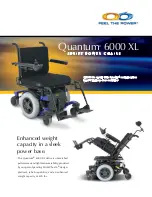
1-11
Twist Owner’s Manual
OM_TWIST_0811RevA
CHAPTER 1: WARNINGS
8. In order to control your speed, ALWAYS keep pressure with your hands on the handrims when going down a hill,
slope or ramp. DO NOT go too fast. Excessive speed may cause you to lose control of your chair, or it may cause
your casters to flutter which can cause a fall or tip-over.
9. ALWAYS lean or press your body in the UPHILL direction. This will help shift your weight to counteract the
change in the center of balance caused by the hill, slope or ramp.
10. ALWAYS ask for assistance if you have any concerns at all about your ability to maintain safe control of your chair
on a hill, slope or ramp.
11. ALWAYS be alert for wet or slippery conditions or surfaces, any changes in the grade of the slope (such as a lip,
bump or depression), and any drop-off or lip at the bottom of a slope. For example, even a 3/4 inch lip at the
bottom of a ramp can cause the casters to stop and cause the chair to tip forward.
12. Ramps at your home and work must meet all legal requirements for your area, including building codes. If you are
having a ramp installed at your home or work, ALWAYS make sure it complies with local legal requirements.
If you ignore these Warnings, you may fall, tip over or lose control of the wheelchair and seriously injure yourself or
others or damage the wheelchair.
J. STAIRS
I
WARNING
NEVER use your wheelchair on stairs without the assistance of at least two (2) able-bodied assistants or attendants
and ONLY AFTER such assistants or attendants have read and understand the Warnings “Climbing a Flight of Stairs”
and “Descending a Flight of Stairs” on page 1-6.
If you ignore these Warnings, you may fall, tip over or lose control of the wheelchair and seriously injure yourself or
others or damage the wheelchair.
K. ESCALATORS
I
WARNING
NEVER use your wheelchair on an escalator, not even with an assistant or attendant.
If you ignore these Warnings, you may fall, tip over or lose control of the wheelchair and seriously injure yourself or
others or damage the wheelchair.
L. ASSISTANTS AND ATTENDANTS
I
WARNING
Before you permit any person to assist you in any aspect of riding your wheelchair, you MUST require that the
assistant or attendant fully read, understand and follow the Warnings contained in this Manual.
If you ignore these Warnings, you may fall, tip over or lose control of the wheelchair and seriously injure yourself or
others or damage the wheelchair.
WARNINGS REGARDING COMPONENTS AND OPTIONS
A. ANTI-TIPS
I
WARNING
Anti-tips are an optional accessory that can help to prevent your chair from tipping over backward. However, even the
use of anti-tips will not guarantee that your chair will not tip over backward. Also, they will not prevent your chair from
tipping over sideways or forward. TiLite strongly recommends you use anti-tips with your wheelchair. This is most
especially true:
a. if you are a new wheelchair rider; or
b. even if you are an experienced rider but you are switching to a new wheelchair, regardless
of whether the prior chair was as lightweight as your TiLite; or
c. even if you are an experienced rider in your TiLite chair but you have made any
modifications or adjustments to the configuration of your chair, such as changing the
position of the front or rear wheels, changing the seat height, changing the camber or changing
Summary of Contents for Twist
Page 1: ...SERIAL NUMBER ______________________ OWNER S MANUAL OM_Twist_0811RevA ...
Page 5: ...OM_TWIST_0811RevA Twist Owner s Manual iii No ...
Page 12: ......
Page 66: ......
Page 82: ......
Page 86: ......
Page 104: ......
Page 117: ......
Page 118: ......
















































